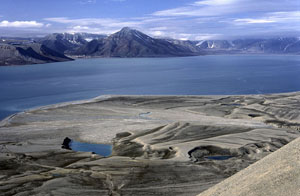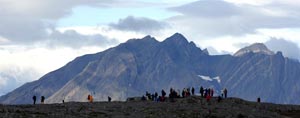 Karst topography at Kapp Ekholm in Billefjorden, one of the fjords branching off Isfjorden. The ponds (sinkholes) are formed as a result of dissolution of the underlying bedrock, which consists of gypsum and anhydrite. The mountain Pyramiden can be seen on the other side of the fjord. (Image: Odd Harald Hansen / The Norwegian Polar Institute)
Karst topography at Kapp Ekholm in Billefjorden, one of the fjords branching off Isfjorden. The ponds (sinkholes) are formed as a result of dissolution of the underlying bedrock, which consists of gypsum and anhydrite. The mountain Pyramiden can be seen on the other side of the fjord. (Image: Odd Harald Hansen / The Norwegian Polar Institute)
 Tourists taking in the grand folds of Sylfjellet, to the west of Bohemanflya. The layered effect is the same as Festningen’s profile. (Image: Jørn Henriksen)
Tourists taking in the grand folds of Sylfjellet, to the west of Bohemanflya. The layered effect is the same as Festningen’s profile. (Image: Jørn Henriksen)
Isfjorden is one of the largest fjords in Svalbard – second only to Wijdefjorden in length – and it leads out to many smaller fjords. The furthest point of Billefjorden, one of these smaller fjords, is a stone’s throw away from the furthest point of Wijdefjorden, extending down from the north. The characteristics of the mountains change as one travels from west to east in Isfjorden. In the west, bedrocks from the Caledonian mountain range, which was formed some 400 million years ago (Silurian/Devonian), can be found. The most prominent example of carbonate rock in this area is Alkehornet, a landmark close to the mouth of Isfjorden. Just below Alkhornet there is a level plain, much like the ones found all along the west coast of Spitsbergen. Parts of this plain have been formed by considerably younger marine depositions. These are less than two million years old.
The cliff of Festningen is situated by the mouth of Grønfjorden, to the south of Isfjorden. A profile of different kinds of rock – all on a slant – is seen here, as is also the case on the island of Akseløya and the peninsula Ahlstrandhalvøya in Billesund. Between the point of Lewinodden and Festningen large parts of Svalbard’s geological history are readily available for viewing. The youngest rocks (from the Tertiary period) can be found along the beach in the east, while old bedrock can be found in the west. In 1960, the first evidence of the existence of dinosaurs in Svalbard was found, in the form of fossils discovered at Festningen. These were footprints from an iguanodon-like herbivorous dinosaur, which is estimated to have lived 125-130 million years ago, that is, early in the Cretaceous period. The mountain wall on which these footprints were found has since collapsed onto the beach. Several other footprints have later been discovered, although less distinct than the first ones. In latter years, fossils of other animals have been found in inner areas of Isfjorden. In 2006 a sensational discovery was made by scientists from the Museum of Natural History in Oslo. They found a fossilized pliosaur, one of the largest carnivorous marine reptiles ever to have existed on Earth.
The profile of rocks that can be seen from Festningen and westwards continues across Isfjorden and also emerges in various northern areas of the fjord.
Prior to the discovery of the pliosaur described in the boxed text, plesiosaurs and ichthyosaurs had been found, both also prehistoric marine reptiles. Discoveries such as these make Svalbard important for palaeontological research. A relative scarcity of vegetation makes fossils easy to find, although the Arctic climate (in which the ground freezes and thaws regularly) means they are found in a porous and vulnerable state. Securing the findings has been difficult and time consuming, and due to a fear of losing something, several emergency digs have had to be carried out. Large fossils are a part of Svalbard’s history and the archipelago’s environmental protection laws are being re-examined with an aim to preserve these findings in the best way possible.
The eastern parts of Isfjorden are characterized by plateau-shaped mountains made up of horizontal layers of sedimentary rocks. Large talus slopes are frequently formed at the base of steep cliffs. When weathering accentuates differences in rocks, spectacular landforms may form. Weathering of more resistant sandstone and limestone layers may result in ridges or pinnacles. Basalt cliffs are present at several places in Isfjorden, for example at Diabasodden. Molten rock of basaltic composition has been injected into fractures in the sedimentary layers and crystallized into hard diabase. Today, the basalt cliffs provide nesting sites for colonies of Brunnich's guillemot and Atlantic puffins.
Some of the broadest U-shaped valleys in Svalbard are found in the Isfjorden area: Sassendalen and Adventdalen. During the last Ice Age, these valleys were outlets for large masses of ice that moved down-valley from east to west. Both valleys are long and flat and meltwater from the glaciers flows in a braided pattern. These rivers transport eroded rock material (particles of gravel, sand and clay) into the fjord. The sediments are deposited in fan-shaped deltas, which in time will turn into stratified sedimentary rocks.
Some landforms are recent. An example is Coraholmen in Ekmanfjorden. In 1896 the glacier Sefströmbreen advanced dramatically fast. Such events of extremely rapid movements are called surges in glaciological terminology. The glacier front advanced rapidly forwards and ploughed the bottom bed of Ekmanfjorden. The debris was thrust up and deposited on Coraholmen. Today the landscape is characterized by hummocky and pitted moraine and abundant small lakes. The hummocky moraine is partly ice-cored and the lakes form as buried ice melts. Abundant shells are present in the deposits on Coraholmen. Deposits from this surge are also found on Flintholmen.